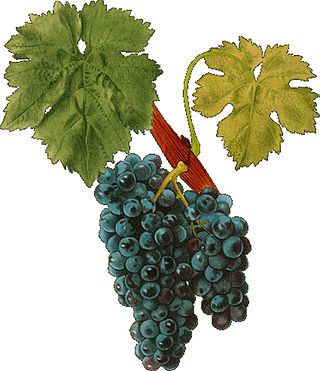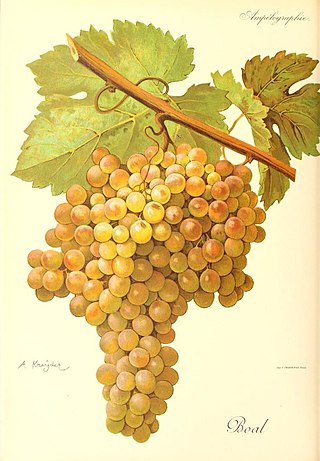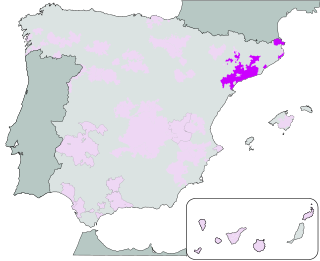
Carignan is a red grape variety of Spanish origin that is more commonly found in French wine but is widely planted throughout the western Mediterranean and around the globe. Along with Aramon, it was considered one of the main grapes responsible for France's wine lake and was a substantial producer in jug wine production in California's Central Valley but in recent years, it has been reborn as a flagship wine for many cellars in the south of France as well as in Catalonia.

Boal is a name given to several varieties of grape cultivated in Portugal, notably in the production of medium-rich fortified wines from Madeira Island. On many wine labels of Madeira wine, the variety's name is anglicized as Bual. Bual from Madeira is typically less sweet than that from Malmsey, but more sweet than Sercial or Verdelho. The vines are also common in Portugal and Spain, where the fruit is used in the same way for fortified wines.

Macabeo, also called Viura or Macabeu, is a white variety of wine grape.

Parellada is a Spanish white grape variety of Catalan origin specially grown in Catalonia, Spain. With Macabeu and Xarel·lo, it is one of the three traditional varieties used to make the sparkling wine Cava, which is primarily produced in Catalonia. Besides its use in Cava, it is used mostly for blending in young white wines, although some more ambitious oaked blends with Chardonnay and Sauvignon blanc are also used. Spanish plantations stood at 10,000 hectares in 2004,

Mencía, known as Jaen in Portugal, is a grape variety native to the western part of the Iberian Peninsula. In Spain, it is planted on over 9,100 hectares, with another 2,500 hectares in neighboring Portugal. It is primarily found in the Bierzo, Ribeira Sacra, Valdeorras, Monterrei and Dão wine regions.

Spanish wine includes red, white, and sparkling wines produced throughout the country. Located on the Iberian Peninsula, Spain has over 1.2 million hectares planted in wine grapes, making it the most widely planted wine-producing nation, but the third largest producer of wine in the world, behind Italy and France and ahead of the United States; this is due, in part, to the very low yields and wide spacing of the old vines planted on the dry soils found in some of the Spanish wine regions. The country is second in wine exports and ninth in worldwide consumption, with Spaniards drinking, on average, 21.6 litres (5.7 US gal) per person a year. The country has an abundance of native grape varieties, with over 400 varieties planted throughout Spain, though 88 percent of the country's wine production is from only 20 grapes — including the reds Tempranillo, Bobal, Garnacha, and Monastrell; the whites Albariño, Airén, Verdejo, Palomino, and Macabeo; and the three Cava grapes Parellada, Xarel·lo, and Macabeo.

Saperavi is an acidic, teinturier-type grape variety native to the country of Georgia, where it is used to make many of the region's most well-known wines. It is also grown in Russia and in lesser quantities in Armenia, Moldova, Ukraine, Uzbekistan, Azerbaijan, Australia.

Empordà is a Spanish Denominación de Origen Protegida (DOP) for wines produced in the northeastern corner of Catalonia, Spain in the province of Girona.

Alella is a Spanish Denominación de Origen (DO) for wines produced in Maresme county in the province of Barcelona in the Spanish autonomous communities of Catalonia, located on the Mediterranean coast, 15 km to the north of the city of Barcelona.

Catalunya is a Spanish Denominación de Origen Protegida (DOP) for Catalan wine which was formally recognised in 2001. It was created with the specific purpose of providing commercial support to over 200 wineries (bodegas) that produced quality wine but which were not included in other specific DOP's in Catalonia. It does not have a specific geographical location but is formed by over 40 km2 of individual vineyards which are dispersed all over Catalonia, and allows mixing of grapes from other DOPs.

Priorat is a Denominació d'Origen Qualificada (DOQ) for Catalan wines produced in the Priorat county, in the province of Tarragona, in the southwest of Catalonia.

Catalan wines are those that are produced in the wine regions of Catalonia. Occasionally, the appellation is applied to some French wine made in the Catalan region of Roussillon and neighboring areas, also known as Northern Catalonia or the Pays catalans. The city of Barcelona is the capital of Catalonia and despite not being in a wine region, it is the focal point of the Catalan wine industry: a primary consumer market, its port provides export functions and a source of financial resources and investment. The Penedès is the largest wine-making region in Catalonia.

Cayetana blanca, also known as Cayetana or Jaén, is a white Spanish wine grape. It is grown mainly in the south of Spain, especially in Extremadura and in the Jerez region where it is distilled for use in brandy production.

Penedès is a Spanish Denominación de Origen Protegida (DOP) for wines in Catalonia, (Spain). Penedès DOP includes all of the Penedès region and municipalities of four other counties: Anoia, Alt Camp, Baix Llobregat and Tarragonès. The area is framed by the coastal hills of the Garraf Massif and the higher inland mountains which skirt the Central Depression.
Cava is a sparkling wine of denominación de origen (DO) status from Spain. It may be white (blanco) or rosé (rosado). The Macabeo, Parellada and Xarel·lo are the most popular and traditional grape varieties for producing cava. Chardonnay and Malvasia are also permitted. Authorized red grapes are Garnacha tinta, Monastrell, Trepat, and Pinot Noir. Only wines produced in the traditional method may be labelled "cava"; those produced by other processes may only be called "sparkling wines". About 95% of all cava is produced in the Penedès area in Catalonia, Spain, with the village of Sant Sadurní d'Anoia being home to many of the largest Catalan production houses. The two major producers are Codorníu and Freixenet. Cava is also produced in other villages in the provinces of Girona, Lleida, Tarragona, and Barcelona in Catalonia, Zaragoza in Aragon, Badajoz in Extremadura, La Rioja, Araba/Álava in the Basque Country, Navarra and València in the Valencian Community.

Montsant is a Spanish Denominación de Origen Protegida (DOP) for wine located in the province of Tarragona and covers 12 municipalities. It was previously known as the Falset subzone of Tarragona (DO), and was created as a separate DO in the early 2000s. Regional approval came in 2001, and from 2002 wines were sold as Montsant rather than Tarragona. Montsant takes its name from the Montsant Mountains in the area.
Borba blanca is a white Spanish wine grape variety grown primarily in the Extremadura region of south central Spain. According to wine expert Jancis Robinson, the grape is of average to low quality and notable mostly for the high productivity and yields of the vine.

Doña Blanca is a white Spanish and Portuguese grape variety that is grown primarily in the northwest Galicia region of Spain and throughout Portugal from the Douro northward. The variety is a permitted grape in the Spanish Denominación de Origens (DOs) of Valdeorras and Monterrei in Galicia and Bierzo in nearby Castile and León. In Spain, the variety is known as Doña Blanca, while in Portugal it goes mainly by the name Dona Branca. The grapes have thick skins, which do well in the wet maritime climate, but it can also impart some astringency and slight bitterness even with the briefest of skin contact during production due to the high proportion of polyphenols in the skin.
Listán Prieto is a red grape variety that is believed to be originated from the Castilla-La Mancha region in Spain. Listán Prieto has disappeared from Spain mainland, but there are still 29 ha planted on the Canary Islands in 2008.

Vinologue is a publisher of an enotourism guidebook series of the same name. It was founded by Miquel Hudin in 2007 with the guides are designed to allow those interested in enotourism to visit "Big Wines from Small Regions" as they focus exclusively on the wines as well as the gastronomy and local culture of small regions throughout the world.

















